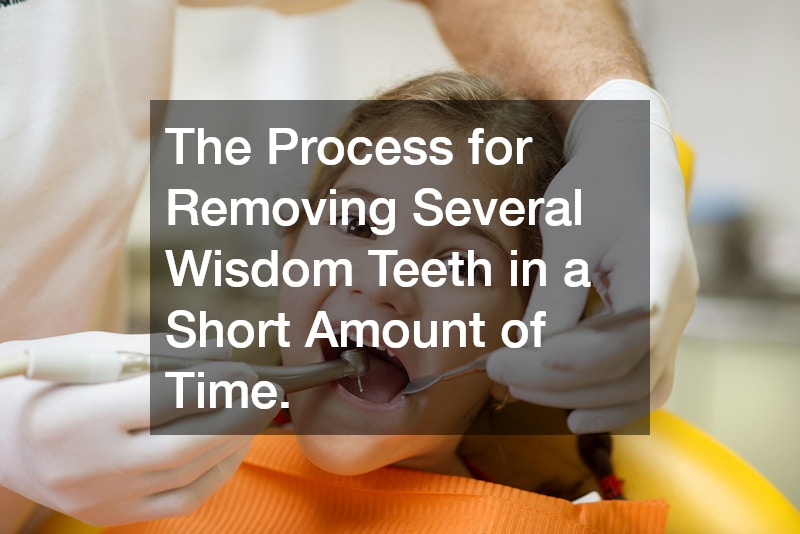When it comes to oral surgery, few procedures are as common as wisdom tooth removal. However, when multiple wisdom teeth need to be extracted at once, patients often wonder how the process can be handled efficiently without sacrificing safety or comfort. Understanding the steps involved, the preparation required, and the recovery process can help make the experience less intimidating. This guide explains how a dentist or oral surgeon can remove several wisdom teeth in a short amount of time while maintaining precision and minimizing discomfort.
Understanding Wisdom Teeth
Wisdom teeth, also known as third molars, usually emerge between the ages of 17 and 25. For many people, there is not enough space in the mouth to accommodate them.
As a result, they can become impacted—trapped under the gum or bone—or grow at odd angles. Impacted wisdom teeth can lead to swelling, infections, cysts, and even misalignment of nearby teeth. Removing them early often prevents future oral health problems.
When several wisdom teeth need to be extracted, the dentist will plan a coordinated approach that allows all teeth to be removed during one appointment. This minimizes the number of procedures, anesthesia sessions, and recovery periods required.
Pre-Surgical Evaluation and Planning
Before any extraction, the dentist conducts a thorough examination. This usually includes a set of digital X-rays or 3D imaging to assess the exact position of each tooth, the depth of the roots, and the proximity to nerves or sinuses. Proper planning is essential for efficiency and safety.
The dentist then reviews the patient’s medical history, including medications, allergies, and existing health conditions. In cases where several teeth will be removed, sedation or general anesthesia is often recommended. This ensures that the patient is comfortable and still during the entire procedure, allowing the surgical team to work quickly and effectively.
Anesthesia and Preparation
The type of anesthesia depends on the complexity of the extraction and the patient’s comfort level. Local anesthesia numbs the surgical areas, while sedation or general anesthesia puts the patient into a sleep-like state. The latter is preferred when multiple teeth are extracted simultaneously because it allows the dentist to work continuously without causing stress or pain.
Before surgery begins, the mouth is cleaned and sterilized. The dental team covers the patient with a protective drape, and monitors are placed to track vital signs throughout the procedure. The goal is to create a controlled and sterile environment for safe, efficient extraction.
The Extraction Process
Once anesthesia takes effect, the dentist begins by focusing on the easiest tooth to remove. This approach helps reduce total surgery time. If a tooth is fully erupted, the dentist can loosen it using a dental elevator and extract it with forceps. However, if the tooth is impacted, a small incision is made in the gum, and sometimes a small portion of bone covering the tooth must be removed.
In more complex cases, the dentist may section the tooth—dividing it into smaller pieces—so that it can be removed safely and with minimal trauma to surrounding tissues. Each tooth is carefully extracted in sequence until all targeted wisdom teeth are removed.
During the process, the dentist works efficiently but methodically, balancing speed with precision. Modern tools such as surgical drills, piezoelectric instruments, and suction devices make it easier to remove multiple teeth quickly without excessive bleeding or tissue damage.
Managing Bleeding and Closing the Sites
After each extraction, the socket is cleaned to remove any debris or fragments. The dentist may place small sutures (stitches) to close the gum and promote faster healing. These sutures are often dissolvable, eliminating the need for a follow-up visit to remove them.
To control bleeding, gauze pads are placed over the extraction sites, and the patient is asked to bite down gently. Within minutes, clotting begins, and the bleeding slows. The entire process—extracting multiple wisdom teeth—can typically be completed in under an hour, depending on complexity.
Post-Surgery Care and Recovery
Once the surgery is finished, the patient is moved to a recovery area while the anesthesia wears off. Most people can go home within 30 to 60 minutes after the procedure. The dental team provides detailed post-operative instructions to prevent complications and ensure smooth healing.
Key aftercare steps include:
Applying ice packs to reduce swelling.
Taking prescribed medications as directed.
Eating soft foods such as yogurt, mashed potatoes, or soup.
Avoiding straws, smoking, or vigorous rinsing to protect the healing clots.
Keeping the head elevated while resting.
Pain and swelling are common for the first few days, but both typically subside within a week. Full healing of the gum tissue can take two to three weeks, but most patients feel well enough to return to normal routines within a few days.
Speed and Safety Factors
When removing several wisdom teeth in a short amount of time, success depends on the dentist’s experience and preparation. Efficiency is not about rushing—it is about minimizing unnecessary movements, anticipating complications, and using the right tools. Skilled dentists rely on precision instruments, proper sedation, and a coordinated team to perform multiple extractions smoothly.
Digital imaging and surgical planning software have also improved timing. By mapping out every movement before surgery begins, the dental team can avoid surprises and reduce total chair time significantly.
The Benefits of Removing All Wisdom Teeth at Once
While it may sound intimidating to remove several teeth in one session, doing so offers clear advantages:
Only one anesthesia or sedation session.
Reduced total recovery time.
Fewer appointments and overall costs.
Symmetrical healing and less risk of uneven bite pressure.
Patients who follow the dentist’s post-operative instructions usually experience a smooth recovery and avoid the need for additional extractions later.
Final Thoughts
The process for removing several wisdom teeth in a short amount of time is a well-coordinated blend of skill, technology, and preparation. From detailed imaging and anesthesia to efficient surgical techniques, every step is designed to ensure the patient’s comfort and safety.

